Minerva
(Adding Article) |
m (Adding author line) |
||
| Line 3: | Line 3: | ||
[[Category:Roman Gods]] | [[Category:Roman Gods]] | ||
| + | ''This article was written by [[Decimus Aurelius Ingeniarius (Nova Roma)|D. Aurelius]], camillus, and should not be modified or copied without permission.'' | ||
[[Image:Minerva_Article_Image_1.jpg|right|thumb|500px|A depiction of Minerva by the artist Joseph Nollekens (1737-1823) on display at the J. Paul Getty Museum, Los Angeles, United States.<ref>Getty Museum Collection, ‘Minerva’, accessed 28 April 24, https://www.getty.edu/art/collection/object/103RRE#full-artwork-details</ref>]] | [[Image:Minerva_Article_Image_1.jpg|right|thumb|500px|A depiction of Minerva by the artist Joseph Nollekens (1737-1823) on display at the J. Paul Getty Museum, Los Angeles, United States.<ref>Getty Museum Collection, ‘Minerva’, accessed 28 April 24, https://www.getty.edu/art/collection/object/103RRE#full-artwork-details</ref>]] | ||
Revision as of 00:57, 16 June 2024
Home| Latíné | Deutsch | Español | Français | Italiano | Magyar | Português | Română | Русский | English
This article was written by D. Aurelius, camillus, and should not be modified or copied without permission.
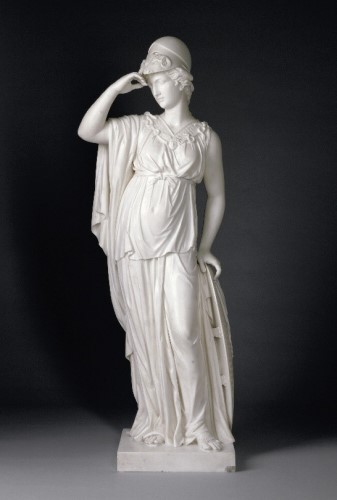
Contents |
Introduction and Origins
The Roman goddess Minerva, is an Italian goddess with patronage over a large domain. She is the patroness for arts and handicrafts[2], and has distinct associations with wisdom and commerce. In spite of her martial-like depictions and guardianship of military prowess and victory, she was also a goddess striving for peace. In addition, she also leads in the sphere of education and study, often looked to by students and academics.[3]Schools were under her particular care, and attending school boys in ancient Rome would have holidays during her festivals. They would often bring a gift to their master, called a “Minerval”.[4]
20th century sources believe that Minerva is, in fact a syncretized adaption of the Greek goddess Athena, borrowed through the times of early Eturia. However, many sources find Minerva to be a native Latin goddess with her name derived from the root of the word memini among others. Despite her native origins, very little traces of her cult exist before the introduction of the “Capitoline Triad”.[5]As mentioned by the poet Ennius in the third century BCE, Minerva was one of twelve gods worshipped through the Roman Republic, as part of a group known as the Dii Consentes or Dii Complices; a great assembly of the gods. The head of this assembly was the Capitoline Triad.[6]
The Capitoline Triad, consists of the deities of Jupiter, Juno and Minerva. This wasn’t always the case as records from pontifical books suggest that this triad displaced a more ancient triad of Jupiter, Mars and Quirinus. King Numa, an early king of Rome, had created the three flamines (leading priests) for this earlier triad that served as the leading gods of Rome and may have been the recipients of the spoils of victory in Rome’s early years[7]. It is first noted that the more recent Capitoline triad with Minerva came to preeminence during the late regal period of Rome during the height of Etruscan influence.[8]Despite the early inconsistencies of Minerva in this triad, several early traces identify her origins beginning with the early assimilation between Athena and the Etruscan Menerva, seen on a relief which decorated the column of a “Temple A” from Pyrgi, dated 480 BCE, on which the Etruscan deity takes part at an episode of the Theban legend. There are further appearances on found Etruscan mirrors which present the Greek theme of the Athena/Menerva birth from the head of Greek Zeus/ Etruscan Tinia, or in the company of Herakles, thus being possible to identify Minerva from King Tarquin’s time.[9]
The image of Athena had a major impact upon the iconography and depiction of the Roman Minerva. There is almost no information available regarding the image of Minerva prior to her visual assimilation with Athena. Although they are identical in terms of appearance, they remained distinctive goddesses within their own pantheon. Despite these similarities, there is almost no information regarding the beginnings of Minerva’s cult in Rome she had no festival in the Feriale Duranum and no flamines were ascribed to her cult.[10]
Festivals & Sacrifices
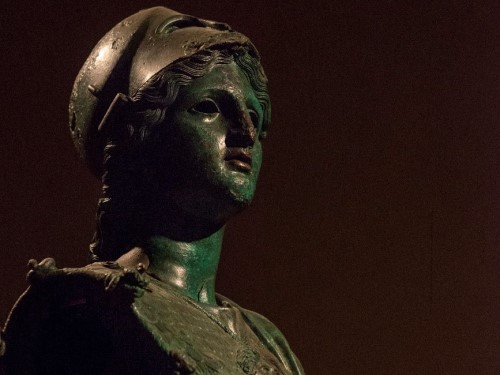
The primary celebration of Minerva is the Quinquatria in March. The name comes from the timing of the event as it coincides with the fifth day after the ides. The event celebrated the anniversary of the temple of Minerva on the Aventine but also extended to include that of Minerva Medica on the Esquiline.[12]
Commencing on the 19th March, the Quinquatria (or Quinquatrus) may have originally been only a single day celebration, according to Varro and Festus. Ovid suggested that it lasted five days and therefore the celebration was afforded its namesake. It may have taken on an additional four days, likely around the time of Julius Caesar, to gratify the people. Ovid suggested that the fifth day of the festival, on March 23, saw the Roman trumpets, used in sacred rites, undergo purification rituals. This purification was more likely to be a separate event known as the Tubilustrium, which hence started the same time as the last day of the Quinquatria.[13]
The Quinquatria celebrated arts and trades including those various professions connected with health. It was marked by days of sacrifices and competitions like gladiatorial games.[14]It became important that on the first day, no blood was shed, so events like the gladiatorial games would commence on the following three or four days. Women would take to consulting fortune-tellers and diviners during this time[15], and may have created textile masterpieces in dedication to the divine patroness which is depicted in activities seen on the frieze of Nerva’s forum.[16]Records show a procession was often held for the occasion at which the treasured Palladium statue, which had allegedly fallen from Olympus, was stated to be carried.[17]
Ovid makes references that coincide with another smaller festival of Minerva, called the Quinquatrus Minusculae or Quinquatrus Minores (Little Quinquatria), that was celebrated on the Ides of June (13th).[18]A contingent of flute players, the tibicines[19], are said to have wandered the streets often masked, drunk and often disguised as women. They would play and finish with a finale in front of the temple of Minerva. According to Turcan (2000), this was likely the temple on the Esquiline, as it is stated the precession would meet again six days later on the 19th at the temple of Minerva on the Aventine.[20]
Seneca writes about other Capitol rituals that would occur. He noted how, along with Juno, Minerva is said to have had dedicated female hairdressers who would gather and move their fingers around in the way a hairdresser would, as if pampering the goddess. Operating some distance from the temple, they were often accompanied by others holding up mirrors.[21]
As one of the chief gods of the state, many public rituals would often be held in front of the temple of the Capitoline Triad. Citizens would often assemble to observe their magistrates and priests address the gods. One of the very first acts of newly elected consuls was to make a sacrifice and offer prayers at this temple.[22]
The college of the epulones, which was made up of the septemviri epulones (although the number of priests numbered ten under the late Republic), had the duty to feed (epulari) the Capitoline Triad deities. Minerva, along with Jupiter and Juno would be fed in a feast, to which senators would also be invited. This was reported to be done originally as part of the Plebeian Games but would become a feature activity into the imperial era with other hosted games.[23]
Temples and Shrines
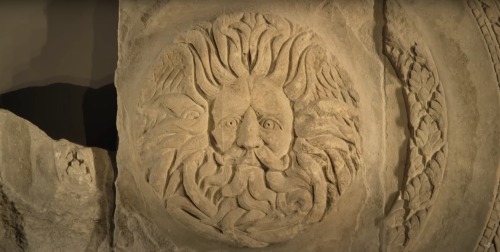
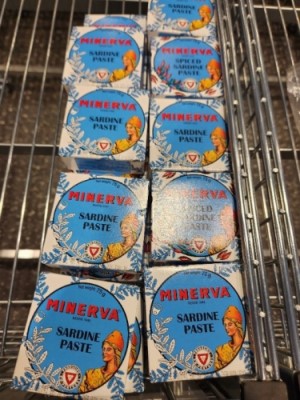
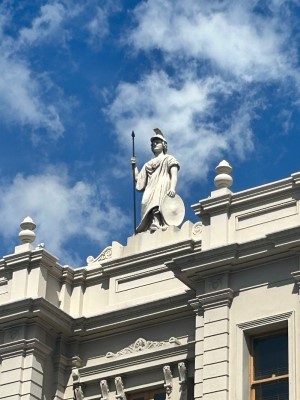
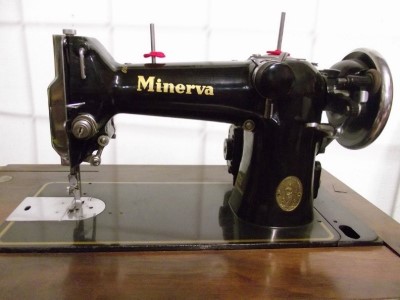
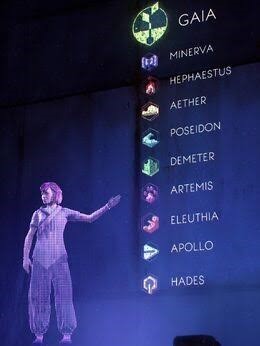
During the early Republic, the great temple of Jupiter on the Capitol was also jointly dedicated to Juno and Minerva. Before the later Republican era of Rome, this temple was of a far greater scale than had been seen in earlier temples. It was Etruscan in design, likely to pay homage to the late regal rulers at the time it was built. However, Republican rhetoric would suggest that although built by the kings of Rome, it was first dedicated in 509 B.C.E by the first consuls of the newly minted Roman Republic.[29]
It became customary to build ‘triple-temples’ (Capitolium) to Jupiter, Juno and Minerva of the state triad through various Coloniae, even through to the empire period as well. Such temples include: the Capitolium at Cosa in Etriria founded in 273 B.C.E. and the Capitolium at Sufetula in Africa founded in the second century C.E.[30]
A key cult temple lay on the Aventine, although it is uncertain when it was established. Most likely built around 263 or 262 BCE.[31]This temple to Minerva became the headquarters of a guild of writers and actors, most prominent during the Second Punic War. Minerva was also worshipped at a smaller shrine on Mons Caelius (Caelian Hill) under the name Minerva Capta. This site was said to be erected after the taking of Falerii in the revolt against the Republic in 241 BCE.[32]Colloquially, this shrine became known as the “Minervium” during the Republic. Identified in sources, likely a shortening of original expression “templum minervium”.[33]
Minerva is found to be one the oldest cults in Pompeii, with the temple there likely built in the early part of the 6th century BCE. The temple likely served as a physical landmark on the edge of the Pompeian lava plateau, with vast views over the entire Sarno valley and the sea. Evidence shows it underwent renovations sometime in the late 4th century BCE where it received a new roof feature depicting Hercules and Athena/Minerva Phrygia.[34]
Other temples were dedicated to Minerva throughout Roman history. Pompey is said to have dedicated one in the later Republican era, funded from the spoils of war.[35]The location of this temple is not known to history but some hypotheses believed it to have been located at the foot of the Pincian Hill. More likely, it is one of two known temple locations located along the triumphal path, consistent with other monuments promoted by Pompey. One of these temples is mentioned in the Cataloghi Regionari and is outside the Porta Capena with other triumphal monuments. The other location could be the temple in the area between the Forum and the Velabrum.[36]Emperor Vespasian is another example to have dedicated new temples to Minerva, alongside the cult of Pax and Domitian.[37]Emperor Domitian, claiming the goddess was protecting him, dedicated a temple in her name in the Nerva Forum.[38]
Variations of Minerva
Julius Caesar reported on the Gallic worship of gods that he described as if they were the same as Roman gods. Although the extant Gallic equivalent is not known today, the Gallic Minerva is also said to bestow the principles of arts and crafts.[39]
Isiac hymns, preserved on inscriptions by the followers of the cult of Isis, suggest that Minerva was in fact, a form of the Egyptian cult figure, Isis, worshipped under another name. This also included the deities of Venus and Magna Mater too.[40]
“Minerva Phrygia” has been evaluated as a pro-Roman cult with a Trojan connection associated with the wider series of foundation myths and Greek identity in the Magna Graecia and Sicily regions. Minerva’s appellative Phrygia (and hence her Trojan background) results from her association with the Palladium and its transport to Rome by Aeneas. Although many cities claimed ownership of the Palladium, its status as one of Rome’s protective relics, and the relationship with Aeneas and Rome’s foundation, suggests that Phrygian Minerva had a wider role in protecting cities and projecting Roman power. One scholar has even suggested that Rome adopted the Phrygian Minerva in southern Italy after its revitalization by Hellenistic monarchs in order to promote the unity of the Greek Italiote league against the threat posed by Apennine populations.[41]
“Minerva Capta” a foreign local goddess who came to Rome after a successful military campaign. This variant is known to us through the writings of Ovid who reports locating the small shrine (parva delubra) in the city and notes its dedication on the goddess’s birthday (March 19). The origin of the name “Capta” is not completely clear, with links to the goddess’ creative talent as “capital”, references to the story that she leapt forth motherless with her shield from her father's head (“caput”), or because she came to Rome as a captive after the conquest of the Falerii. Although Ovid himself references inscriptions and evidence noting the arrival via the conquest.[42]
“Sulis Minerva” arose from the occupation of Britian after the Romans started identifying the local Celtic goddess Sulis, with Minerva. With evidence found in Bath within Britain, the identities of both goddesses can be found in hybrid.[43]Sulis Minerva is said to have presided over the hot springs in Bath which can exceed 40 degrees Celsius. This saw the goddess as a patroness of healing in this aspect.[44]
Minerva in Modern Society & Pop Culture
Likely due to the vast portfolio the goddess has scope over, as well as her hegemony over wisdom, knowledge, martial prowess and education, Minerva and her image has permeated across cultures through to the present day. From various university and government projects labeled “Minerva”, through to sewing machines and various foods, Minerva has come to be associated with quality and high standards. (See Images)
Minerva in Nova Roma
Minerva was famously honored on the seventh day of the Nova Roman ludi Conditorium, a.d. IV Non. Mar. ‡M. Moravio T. Iulio cos. ‡ MMDCCLXI a.u.c. (2761 a.u.c). These games were in celebration of the 10th anniversary of the founding of Nova Roma included chariot races, literary contests and history quizzes.[45]
Minerva also features as one of three deities honored as patrons of the newly founded Collegium Iurisprudentium, formed in M. Cotta C. Petronio cos. ‡ MMDCCLXXVII a.u.c. This collegium is dedicated to the study of ancient Roman law and its application in Nova Roma. The Collegium aims to provide a service to the Res Publica by offering subject matter expertise to magistratus and cives alike.[46]
The Nova Roma Collegium Pontificum appointed D. Aurelius Ingeniarius as a camillus, trainee priest for Minerva, in C. Cethego Q. Arrio (IV) cos. ‡ MMDCCLXXVI a.u.c. under Decretum pontificum de camillis novis.
References
- ↑ Getty Museum Collection, ‘Minerva’, accessed 28 April 24, https://www.getty.edu/art/collection/object/103RRE#full-artwork-details
- ↑ Hammond, N and Scullard, H. The Oxford Classical Dictionary, (London: Oxford University Press, 1970), p. 689.
- ↑ Nicolae, M, The Capitoline Triad In Roman Dacia, Peuce S.N. IX, 2011, p. 294.
- ↑ Belton, J, An Encyclopedia of Ancient Greek and Roman Mythology, 2009, p. 180
- ↑ Hammond, N and Scullard, H. The Oxford Classical Dictionary, p. 689.
- ↑ Nicolae, M, The Capitoline Triad In Roman Dacia, p. 292.
- ↑ Mary Beard, John North and Simon Price, ‘Religions of Rome, Volume 2 A Sourcebook’ (New York: Cambridge University Press, 1998), 6.
- ↑ Beard, North and Price, ‘Religions of Rome Vol 2.’, 24.
- ↑ Nicolae, M, The Capitoline Triad In Roman Dacia, p. 292.
- ↑ Ibid, p. 299.
- ↑ World History Encyclopedia, ‘Minerva of Arezzo’, accessed 28 April 24,https://www.worldhistory.org/image/2270/minerva-of-arezzo/.
- ↑ Robert Turcan, “The Gods of Ancient Rome”, (Edinburgh: Edinburgh University Press, 2000), 67.
- ↑ Bill Thayer, Quinquatrus or Quinquatria, ‘LacusCurtius: Into the Roman World’, last modified December 17, 2006, accessed March 10, 2024, https://penelope.uchicago.edu/Thayer/E/Roman/Texts/secondary/SMIGRA*/Quinquatrus.html
- ↑ Turcan, “The Gods of Ancient Rome”, 67.
- ↑ Thayer, Quinquatrus or Quinquatria.
- ↑ Turcan, “The Gods of Ancient Rome”, 67.
- ↑ Jordan, M, Dictionary of Gods and Goddess, (Facts on File New York, 2004), p. 200.
- ↑ Turcan, “The Gods of Ancient Rome”, 74.
- ↑ Thayer, Quinquatrus or Quinquatria
- ↑ Turcan, “The Gods of Ancient Rome”, 74.
- ↑ Beard, North and Price, ‘Religions of Rome Vol 2.’, 234.
- ↑ Frances Hahn, “Performing the Sacred: Prayers and Hymns”, in A Companion to Roman Religion, ed. Jörg Rüpke (Malden: Blackwell Publishing, 2007), 238.
- ↑ Robert Turcan, “The Gods of Ancient Rome”, (Edinburgh: Edinburgh University Press, 2000), 55.
- ↑ Odyssey – Ancient History Network, The Complete History Of the Roman Empire.
- ↑ Poveira, Minerva Preserves, accessed 16 April 2024, https://www.apoveira.pt/conservas-peixe/conservas-minerva/
- ↑ Ballaarat Mechanics' Institute, ‘About Us’, accessed 28 April 24, https://ballaratmi.org.au/about-us/.
- ↑ Minerva, History, accessed 16 April 2024, https://www.minerva-boskovice.com/company/history.
- ↑ FANDOM Games, MINERVA, accessed 16 April 2024, https://horizon.fandom.com/wiki/MINERVA.
- ↑ Beard, North and Price, ‘Religions of Rome Vol 2.’, 24.
- ↑ Beard, North and Price, ‘Religions of Rome Vol 2.’, 245.
- ↑ Madden, A, Ancient Gods, (London: Future Publishing 2022), p. 76
- ↑ Hammond, N and Scullard, H. The Oxford Classical Dictionary, p. 689.
- ↑ Cinaglia, T, ‘Minervium vs. Minerva Capta: due facce della stessa medaglia?’, en Ἰlu. Revista de Ciencias de las Religiones 21, p. 54.
- ↑ Graff, I. and Ellis, J, Minerva, urban defenses, and the continuity of cult at Pompeii, Journal of Roman Archaeology 30 (2017), p. 293.
- ↑ Beard, North and Price, ‘Religions of Rome Vol 1.’, 122.
- ↑ Eleonora Zampieri, “Pompey, Minerva and Rome’s Presence in the Near East”, Hermes 148 (March 2020): 326.
- ↑ Beard, North and Price, ‘Religions of Rome Vol 1.’, 253.
- ↑ Madden, Ancient Gods, p. 76.
- ↑ Beard, North and Price, ‘Religions of Rome Vol 2.’, 55.
- ↑ Beard, North and Price, ‘Religions of Rome Vol 1.’, 281.
- ↑ Graff and Ellis, Minerva and the continuity of cult at Pompeii, p. 293.
- ↑ Miller, J, ‘The "Fasti" And Hellenistic Didactic: Ovid's Variant Aetiologies’, Arethusa, Vol. 25, No. 1, Reconsidering Ovid's fasti (Winter 1992), p. 25.
- ↑ Odyssey – Ancient History Network, The Complete History Of the Roman Empire, uploaded on April , 2023, video, 2:36:43, https://www.youtube.com/watch?v=P3IIRiSTc3g&ab_channel=Odyssey-AncientHistoryDocumentaries
- ↑ Eberhard Sauer, An inscription from Northern Italy, the Roman Temple Complex in Bath and Minerva as a Healing goddess in Gallo-Roman Religion, Oxford Journal of Archaeology, 15(1) 1996: 65
- ↑ Nova Roma Inc., Ceremony to Minerva ~ Ludi Conditorum 2761 AUC (Nova Roma), accessed 16 April 2024, http://www.novaroma.org/nr/Ceremony_to_Minerva_%7E_Ludi_Conditorum_2761_AUC_(Nova_Roma)
- ↑ Nova Roma Inc., ‘Collegium Iurisprudentium Charter, v2.0, accessed 28 April 24, https://discord.gg/PHg3geUGUR.
Master Index
Master Index
Master Index > Maintenance Categories > Pages to be deleted > English > Ancient Rome > Roman religion
Master Index > Maintenance Categories > Pages to be deleted > English > Ancient Rome > Roman religion > Roman Gods
Master Index > Maintenance Categories > Pages with content needing verification